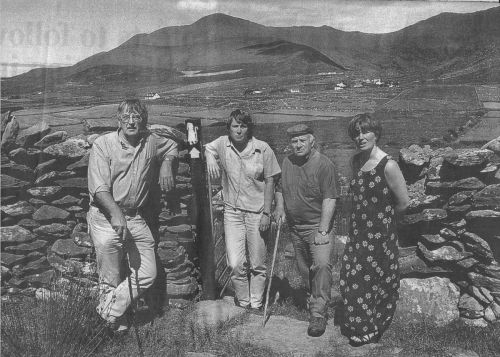
Page
Out
Records
Kerry
Links
 | ||||
| Home Page | Starting Out | Online Records | Research Kerry | Resource Links |
Irish Times
Tuesday, July 11, 2000
Southern Report
"Work to improve some of Ireland's pilgrim pathways is being completed as part of a project to benefit eco-tourism as well as ramblers and pilgrims.
Seeking out ancient trails has become big business all over Europe. People want to discover what the pilgrims endured as they made their way along often tortuous paths to a sacred location.
Three years ago various interest groups met to consider popularising the old trails, parts of which were long forgotten. The idea was that State agencies such as Dúchas, Coillte, Údaras na Gaeltachta, FÁS, Bord Fáilte, local authorities and the LEADER programme could combine with communities to highlight the pilgrim routes and make them presentable once more to people who want to explore the historic countryside.
There was a double advantage in the plan. First, the restoration of the scenic and historic routes could only enhance the counties through which they passed. Second, there is no better or more environmentally friendly tourist than the one who wants to leave things in as good a condition as they were found. And at the end of the day's trek, these tourists know how to soothe tired limbs with good food and drinks.
Mr Ted Creedon, the co-ordinator of the project, says that after much work, study and preparation it is finally coming together.
Six pilgrimage routes have been earmarked by Dúchas. They are: Ventry beach to the foot of Mount Brandon in Kerry, known locally as Saint's Road (10 miles); Lismore/Cappoquin to Ardmore, Co Waterford, where St Declan founded his monastery (20 miles); Pettigo to Saint's Island in Lough Derg, believed to be the original destination of pilgrims (five miles); Ballintubber Abbey to Croagh Patrick, Co Mayo (22 miles); Hollywood, Co Wicklow, to Glendalough, site of St Kevin's monastic settlement (18 miles); and Ballycumber, Co Offaly, to Clonmacnoise (18 miles), site of St Kieran's settlement.
Markers, stiles and wooden bridges currently being installed along three of these paths - Kerry, Wicklow and Waterford - and work is expected to start soon on the others.
Dúchas has chosen a special logo for the route markers, a figure with a staff.
Finding the old routes again and preparing them was more than a matter of simply clearing away the weeds. The question of crossing land has become a fraught one due to issues of public liability.
This has been resolved, and in all cases the local authorities in whose jurisdiction the walks are situated will provide indemnity once the route has received approval. The National Waymarked Ways Committee, through Mr Joss Lynam, recommended that each walk be inspected and advice given on signage, markers, stiles and all that goes with making a walk a safe and pleasant experience.
Local committees were very much involved also in providing useful hints and help. And it didn't end there. Dúchas commissioned Dr Mary Tubridy, a consultant environmentalist, to conduct a study of the walks under the headings: flora/fauna; archaeology; architecture and geology.
Experts in these areas walked the trails some months ago, making detailed notes. This information will form the benchmark against which measurements can be taken to determine whether or not the environment is suffering as a result of plodding feet.
Guides to each route are being prepared by Dr Peter Harbison, a scholar of medieval pilgrimage, and the first one is due out by the end of the year.
This is a worthy effort by Dúchas and comes at a time when local communities are doing their bit to restore walks and to make them more enjoyable. It doesn't have to be a pilgrimage walk, of course, but pilgrim trails do have their own lure.
Pilgrimage has been taken as the theme for the millennium year by the Catholic Hierarchy, and pilgrimage will be the theme of a three-day conference on the subject on July 26th to 28th at UCC. It will have 90 speakers from around the world and will focus especially on the great pilgrim routes to Jerusalem, Rome and Santiago as well as the Irish routes.
The conference is being organised by Dr Dagmar Ó Riain-Raedel of UCC's history department. Members of the German Society of St James (the St James brotherhood is dedicated in various countries to promoting the great European trail to Santiago de Compostela in north-western Spain) has been in touch with her for information on Irish pilgrim trails, and members of the group want to come to Ireland next year.
The UCC conference will explore all aspects of pilgrimage including history, art, music, spirituality and literature and promises to bring together many eminent scholars in the field."

Mr. Ted Creedon, national co-ordinator of the Dúchas Pilgrim Paths project, Ms Máire Ní Mhainín, of Údarás na Gaeltachta, Mr T.P. Ó Conchúir, chairman of the Cosán na Naomh committee, and Ms Susan Ní Churnáin, of Gaelsaoiore, on the pilgrim path from Ventry to Mount Brandon, Co. Kerry.
Photograph: David Sleator

This map and other wonderful information is in a must read book for Dingle Peninsula fans; "The Dingle Peninsula - History Folklore Archeology" by Steve MacDonogh